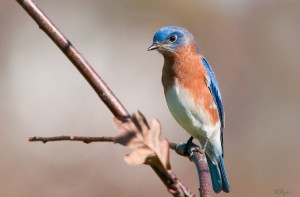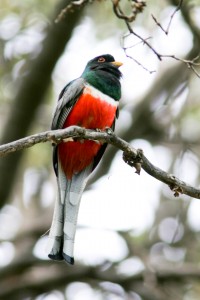Global IBA for Mexican Spotted Owl
Size: 452.5 square miles, 289,600 acres
Identified: 04/2003. Global:10/2009
Visiting the IBA: From Sierra Vista go east on Hwy 90 then south on Hwy 80 to Bisbee; continue east on Hwy 80 to Douglas; continue northeast on Hwy 80 to Rodeo, NM; and finally go west on Portal Road about 2 miles north of Rodeo. This route is entirely blacktop and is an all-weather route.
Site Description: This IBA encompasses the large “sky island” mountain range, the Chiricahua Mountains in southeastern Arizona almost 40 miles long by 20 miles wide. The IBA extends from 5000 feet elevation, at the ecotone between grassland and oak, to the top of Chiricahua Peak at 9795 feet. Sierra Madrean species reach the northernmost extension of their ranges within this IBA. This IBA is notable for the incredible diversity of bird, mammal, reptile and amphibian species that occur here due to the numerous life zones that overlap in this sky island.
Birds: The Chiricahua Range is where the interior Rocky Mountain and the northern Sierra Madrean avifauna meet, making this IBA a coveted bird watching destination. This IBA is within the Portal Christmas Bird Count circle. Species of special conservation status and interest that use the habitats within this IBA include:
Year-round: Wild Turkey (Gould’s race), Scaled Quail, Montezuma Quail, Prairie Falcon, Peregrine Falcon, Mexican Spotted Owl, Arizona Woodpecker, Mexican Chickadee (found only in the Chiricahua and Animas Mountains in the U.S.), Eastern Bluebird, Yellow-eyed Junco, Black-chinned Sparrow, Abert’s Towhee, and Pyrrhuloxia.
Breeding: Band-tailed Pigeon, Short-tailed Hawk (rare), Apache Goshawk, Golden Eagle, Elegant Trogon, Eared Quetzal (rare), Broad-billed Hummingbird, Magnificent Hummingbird, Violet-crowned Hummingbird, Lucifer Hummingbird, Costa’s Hummingbird, Flammulated Owl, Whiskered Screech-Owl, Elf Owl, Greater Pewee, Sulphur-bellied Flycatcher, Cordilleran Flycatcher, Buff-breasted Flycatcher, Crissal Thrasher, Grace’s Warbler, Olive Warbler, Virginia’s Warbler, Lucy’s Warbler, Black-throated Gray Warbler, Red-faced Warbler, Historically, Thick-billed Parrots occupied the Chiricahua Mountains
Migration: Blue-throated Hummingbird, Rufous Hummingbird, Calliope Hummingbird, Red-naped Sapsucker, Williamson’s Sapsucker (winter), Olive-sided Flycatcher, Gray Flycatcher, MacGillivray’s Warbler, Brewer’s Sparrow
Conservation Concerns: Historic grazing and soil erosion. Uncontrollable wild fires have plagued this IBA over the past decade. The higher elevation mixed conifer forest habitats have been severely impacted by recent fires.
Maps of this Important Bird Area:
State of the IBAs 2014 Baseline – More Technical info about the status of this Important Bird Area
National Audubon Profile Page for Chiricahua Mountains IBA
Complete eBird.org Checklist of birds Reported for Chiricahua Mountains IBA
For an interactive map and habitat and land ownership analysis of this IBA visit the National Audubon IBA Map and select “Arizona” and then the name of this Important Bird Area. To access analysis graphs, click on the map boundary of the IBA.
Location: 31.9057°N: 109.2800°W
County: Cochise
Site Status: Identified 04/2003, Identified Global 10/2009
Ownership: Coronado National Forest
Criteria: A1 Global Site – Spotted Owl
B1(Potential): Continental: Species of Conservation Concern (Arizona Woodpecker, Montezuma Quail, Whiskered Screech Owl, Hummingbirds, Yellow-eyed Junco)
D1: State: Species of Conservation Concern
D3: State: Species in rare/unique habitat
 Site Description: Sierra Madrean species reach the northernmost extension of their ranges within this IBA. Notable are many bird species, but also mammals like jaguarundis, and trees like the Apache pine. Numerous perennial springs and streams occur within the range, although none flow out of the mountains into the surrounding Chihuahuan desert scrub. The main canyons of the range include: West Turkey Creek, Rucker, and Cave Creek.
Site Description: Sierra Madrean species reach the northernmost extension of their ranges within this IBA. Notable are many bird species, but also mammals like jaguarundis, and trees like the Apache pine. Numerous perennial springs and streams occur within the range, although none flow out of the mountains into the surrounding Chihuahuan desert scrub. The main canyons of the range include: West Turkey Creek, Rucker, and Cave Creek.
| Vegetation Description | Hectares |
| CYPRESS POSTCLIMAX COMMUNITIES | 249.9888 |
| DESERT GRASSLAND & CHIHUAHUAN DESERTSCRUB | 62260.31 |
| DOUGLAS FIR – WHITE FIR COMMUNITIES | 1203.512 |
| ENCINAL OAK COMMUNITIES | 3812.918 |
| EVERGREEN SCLEROPHYLL COMMUNITIES | 1980.363 |
| GRAMA GRASS – SCRUB COMMUNITIES | 6956.428 |
| MESQUITE SCRUB COMMUNITIES | 62763.07 |
| MEXICAN OAK – PINE COMMUNITIES | 21924.44 |
| MIXED BROADLEAF COMMUNITIES | 381.2311 |
| MIXED GRASS – SCRUB COMMUNITIES | 220579.7 |
| PINE COMMUNITIES | 7401.419 |
| PINYON – JUNIPER COMMUNITIES | 6745.888 |
| PINYON – OAK COMMUNITIES | 23490.66 |
| QUERCUS EMORYI – JUNIPERUS ASSOCIATIONS | 45024.82 |
| SHRUB – GRASS – SCRUB DISCLIMAX COMMUNITIES | 13805.62 |
| SPRUCE – ALPINE FIR COMMUNITIES | 393.6164 |
Ornithological Summary:
| Species or group | Season | Maximum | Year |
| Elegant Trogon | Breeding | 14 pairs (avg.) | 1995 |
| Buff-breasted Flycatcher | Breeding | 22 individuals (counted) | 1996 |
| Golden Eagle | Breeding | 10 pairs (avg.) | 1993 |
| Peregrine Falcon | Breeding | 12 pairs (avg.) | 1993 |
| Whiskered Screech-Owl | Resident | Fairly Common | 1997 |
| Elf Owl | Breeding | Common | 1997 |
| Mexican Spotted Owl | Breeding | 2 pairs (counted) | 1994 |
| Arizona Woodpecker | Resident | Fairly Common | 1997 |
| Lucifer Hummingbird | Breeding | ||
| Hummingbirds | Breeding | Broad-billed, Violet-crowned, Costa’s Hummingbird | |
| Bell’s Vireo | Breeding | Common | 1997 |
| Lucy’s Warbler | Breeding | Common | 1997 |
The Chiricahua Range is where the interior Rocky Mountain avifauna meet the northern Sierra Madrean avifauna, as well as a mixing of the Sonoran, Chihuahuan, and Great Basin desert avifauna. Some 375 bird species are known to inhabit the Chiricahua Mountains IBA (Taylor 1997). Of particular ornithological importance, is the great number of Mexican species whose northern summer breeding range occurs only in the southern “sky island” mountains of Arizona, these species include: Elegant Trogon, Whiskered Screech-Owl, Violet-crowned Hummingbird, Sulphur-bellied Flycatcher, and Mexican Chickadee (the latter found only in the Chiricahua and Animas Mountains in the U.S.). The Elegant Trogon population is the second largest group in the United States after the population within the Huachuca Mountains IBA.  Fifteen species of hummingbirds have bred in the IBA. This IBA supports 33 (breeding or resident) Species of Conservation Status, most notably a high percentage of the state population of: Whiskered Screech-Owl, Arizona Woodpecker, Buff-breasted Flycatcher, Grace’s Warbler, and possibly Crissal Thrasher. Within the last ten years Short-tailed Hawks have nested within this IBA. Historically, Thick-billed Parrots occupied the Chiricahua Mountains, and the habitat remains little changed. Twenty-six birds were reintroduced in 1986, but the reintroduction attempt failed, apparently to the inexperience of the individuals released and predation by raptors.
Fifteen species of hummingbirds have bred in the IBA. This IBA supports 33 (breeding or resident) Species of Conservation Status, most notably a high percentage of the state population of: Whiskered Screech-Owl, Arizona Woodpecker, Buff-breasted Flycatcher, Grace’s Warbler, and possibly Crissal Thrasher. Within the last ten years Short-tailed Hawks have nested within this IBA. Historically, Thick-billed Parrots occupied the Chiricahua Mountains, and the habitat remains little changed. Twenty-six birds were reintroduced in 1986, but the reintroduction attempt failed, apparently to the inexperience of the individuals released and predation by raptors.
Conservation Issues: Historically, livestock grazing has caused the greatest stress to the perennial streams of the canyons, and has caused local impacts.
The U.S. Forest Service does not permit livestock grazing in Cave Creek Canyon, and around campgrounds in the higher elevations, but grazing does occur in the lower elevations, and the impacts can be significant in terms of erosion and loss vegetation and biotic diversity. Fire risk due to illegal alien traffic is a concern.










